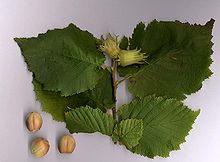Betulaceae
This article includes a list of general references, but it lacks sufficient corresponding inline citations. (March 2013) |
| Betulaceae Temporal range:
| |
|---|---|

| |
| Black alder (Alnus glutinosa) | |
| Scientific classification | |
| Kingdom: | Plantae |
| Clade: | Tracheophytes |
| Clade: | Angiosperms |
| Clade: | Eudicots |
| Clade: | Rosids |
| Order: | Fagales |
| Family: | Betulaceae Gray[1] |
| Type genus | |
| Betula | |
| Subfamilies and genera | |
|
See text | |

| |
| The range of the Betulaceae | |

Betulaceae, the birch family, includes six genera of deciduous nut-bearing trees and shrubs, including the birches, alders, hazels, hornbeams, hazel-hornbeam, and hop-hornbeams numbering a total of 167 species.[2] They are mostly natives of the temperate Northern Hemisphere, with a few species reaching the Southern Hemisphere in the Andes in South America. Their typical flowers are catkins and often appear before leaves.
In the past, the family was often divided into two families, Betulaceae (Alnus, Betula) and Corylaceae (the rest). Recent treatments, including the Angiosperm Phylogeny Group, have described these two groups as subfamilies within an expanded Betulaceae: Betuloideae and Coryloideae.
Betulaceae flowers are monoecious, meaning that they have both male and female flowers on the same tree. Their flowers present as catkins and are small and inconspicuous, often with reduced perianth parts. These flowers have large feathery stamen and produce a high volume of pollen, as they rely on wind pollination. Their leaves are simple, with alternate arrangement and doubly serrate margins.
Evolutionary history
The Betulaceae are believed to have originated at the end of the Cretaceous period (about 70 million years ago) in central China. This region at the time would have had a Mediterranean climate due to the proximity of the Tethys Sea, which covered parts of present-day Tibet and Xinjiang into the early Tertiary period. This point of origin is supported by the fact that all six genera and 52 species are native to this region, many of those being endemic. All six modern genera are believed to have diverged fully by the Oligocene, with all genera in the family (with the exception of Ostryopsis) having a fossil record stretching back at least 20 million years from the present.
According to molecular phylogeny, the closest relatives of the Betulaceae are the Casuarinaceae, or the she-oaks.[3]
Uses

The common hazel (Corylus avellana) and the filbert (Corylus maxima) are important orchard plants, grown for their edible nuts.
The other genera include a number of popular ornamental trees, widely planted in parks and large gardens; several of the birches are particularly valued for their smooth, brightly coloured bark.
The wood is generally hard, tough and heavy, hornbeams particularly so; several species were of significant importance in the past where very hard wood capable of withstanding heavy wear was required, such as for cartwheels, water wheels, cog wheels, tool handles, chopping boards, and wooden pegs. In most of these uses, wood has now been replaced by metal or other man-made materials.
Subfamilies and genera
Extant species
- Betuloideae
- Coryloideae
- Carpinus L. 1753 – hornbeam
- Corylus L. 1753 – hazel
- Ostrya Scop. 1760 – hop-hornbeam
- Ostryopsis Decne. 1873 – hazel-hornbeam
Fossils
- †Asterocarpinus
- †Coryloides
- †Cranea
- †Kardiasperma
- †Palaeocarpinus
Phylogenetic systematics
Modern molecular phylogenetics suggest the following relationships:[3][4][5]
| |||||||||||||
References
- ^ Angiosperm Phylogeny Group (2009), "An update of the Angiosperm Phylogeny Group classification for the orders and families of flowering plants: APG III", Botanical Journal of the Linnean Society, 161 (2): 105–121, doi:10.1111/j.1095-8339.2009.00996.x
- ^ Christenhusz, M. J. M. & Byng, J. W. (2016). "The number of known plants species in the world and its annual increase". Phytotaxa. 261 (3). Magnolia Press: 201–217. doi:10.11646/phytotaxa.261.3.1.
- ^ a b Soltis DE, Smith SA, Cellinese N, Wurdack KJ, Tank DC, Brockington SF, Refulio-Rodriguez NF, Walker JB, Moore MJ, Carlsward BS, Bell CD, Latvis M, Crawley S, Black C, Diouf D, Xi Z, Rushworth CA, Gitzendanner MA, Sytsma KJ, Qiu YL, Hilu KW, Davis CC, Sanderson MJ, Beaman RS, Olmstead RG, Judd WS, Donoghue MJ, Soltis PS (2011). "Angiosperm phylogeny: 17 genes, 640 taxa". Am J Bot. 98 (4): 704–730. doi:10.3732/ajb.1000404. PMID 21613169.
- ^ Xiang X-G, Wang W, Li R-Q, Lin L, Liu Y, Zhou Z-K, Li Z-Y, Chen Z-D (2014). "Large-scale phylogenetic analyses reveal fagalean diversification promoted by the interplay of diaspores and environments in the Paleogene". Perspectives in Plant Ecology, Evolution and Systematics. 16 (3): 101–110. doi:10.1016/j.ppees.2014.03.001.
- ^ Chen Z-D, Manchester SR, Sun H-Y (1999). "Phylogeny and evolution of the Betulaceae as inferred from DNA sequences, morphology, and palaeobotany". Am J Bot. 86 (8): 1168–1181. doi:10.2307/2656981. JSTOR 2656981. PMID 10449397.
